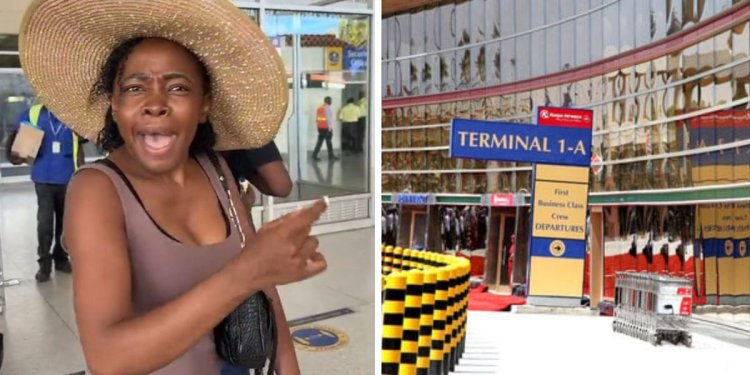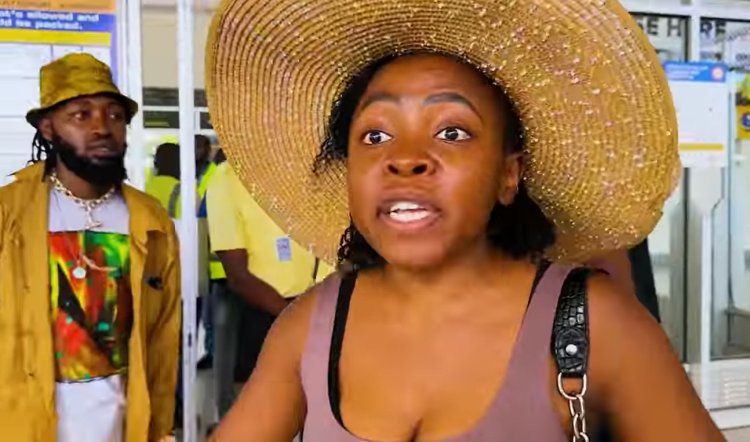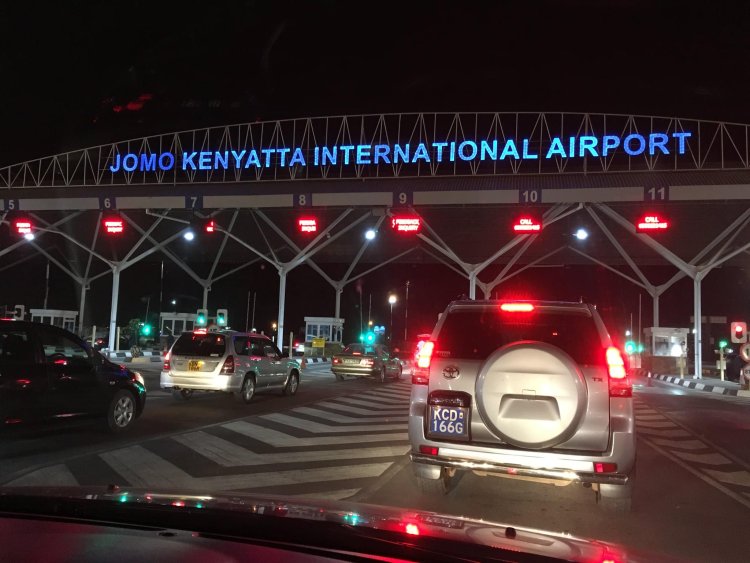Miss Trudy: When You Can & Cannot Take Photos, Videos At An Airport
A deeper look into the video showed the security officers trying to reason with her...

Popular YouTube content creator, Gertrude Awino Njeri Juma, popularly known as Miss Trudy, went viral on Tuesday, April 18 complaining that she had been harassed by security officials at the Moi International Airport in Mombasa.
Miss Trudy claimed that she did nothing wrong in filming at the airport, adding that content creators had the right to film at any airport in the country.
"We got arrested for filming at the Airport! This is getting out of control! We have a right to create content without intimidation!" she wrote.
However, a deeper look into the video showed the security officers trying to reason with her, even though she berated the officers for denying her the freedom of expression as provided for in the Constitution of Kenya.
Content creator Miss Trudy confronting security officers on Tuesday, April 18, 2023. /MISS TRUDY
Undoubtedly, filming content at airports as a filmmaker, vlogger, or content creator can add some depth and authenticity to your work and pull audiences who may not have witnessed international travel in their lives.
It does not mean though that every single nook, cranny and minute at an airport is worthy of a photo or a video shouting "Welcome to my YouTube shanoool."
Viral Tea examines when and where you can and cannot film while at an airport:
It is arguably common sense not to film at security checkpoints that include bag screening areas, body security booths, immigration counters or through customs.
In Miss Trudy's case, the major blunder was filming while at the entrance of the Moi Airport where she was not only obstructing other passengers from getting through the checks on their way to checking in to the flight but also pose potential security risks.
The screening and customs checks are most likely crawling with private data and items which pass through the hands of airport officials before they allow passengers to board their flight, be it domestic or international. Because today's camera lenses on phones have bigger megapixels that capture vivid detail and can zoom with less grainy detail, something as simple as passport details can end up on social media in a flash.
Think of it this way, would you want your village mates to suddenly know through Twitter that you're sneaking out of their home in upcountry to relocate to Canada because a photogenic content creator mistakenly captured your bag being screened, a bag that even your grandmother knows its colour?
"We have areas at the airport that are highly diluted including where she was filming, she was at the primary security screening area before check-in," a Kenya Airports Authority (KAA) official told Viral Tea.

Security Screening
Airport Security and Airline Agents
When filming in the airport, you must be mindful of people's privacy rights. Yes, that also includes security officers and those airline employees at the check-in counter, especially when arguments ensue.
In Miss Trudy's case, she was filming in an airport which is in use by many people without their consent which is against the law. It's like taking a picture of someone without asking them if they can take a picture, and in the era of social media where it takes a photo to trigger an uproar, filming an airport official can even put their life at risk.
According to the Civil Aviation Security Regulations, the airport staff were well within their rights to stop her from filming especially if she had not sought prior authorization. Any person who interferes with the performance of duties of aviation security officers or lessens their ability to perform those duties has committed an offence.
Further, refusal to follow lawful instructions given by the airport operator for the purpose of ensuring order and safety at the airport is also an offence. Such a person is liable, on conviction, to a fine not exceeding Ksh1 million or imprisonment not exceeding one year or both.
The rules for filming non-government airline agents are different from government agents. Private companies carrying private passengers are subject to additional policies and procedures, that is, some airlines restrict the use of still and video cameras, film or digital to recording personal events and not to recording airline personnel, equipment, or procedures, with any violations meaning airline officials can deny you from travelling.
Restricted Areas For Photography At Airports
Any visible sign that says "No Photography" means the message is simple, no photography. These are usually in areas where your presence is deemed by the airport authority as hazardous to your or other people's safety, impedes operations, or causes a potential threat to security.

Entrance to Jomo Kenyatta International Airport. /FACEBOOK
According to Airport Nerd, these areas include runways, taxiways, customs checkpoints, loading docks, and border control, among others. Check-in and gate areas may also be off-limits to photography unless given permission by the airline.
Be cautious when taking photos of people on private grounds, even if they are in plain view. However, taking photos/videos from a public space of an image situated on private property but in plain view is generally allowed.
A passenger photographing another passenger or a check-in agent of the airline he or she is flying with may result in being ordered off the plane. However, a passenger photographing an airline's employee, but flying with a different airline might get away with it, as the latter couldn't impose their policies on another airline's passengers.
So Where Do You Take Photos at An Airport?
Airports used to be known as gateways where one goes from point A to B. However, some airports around the world have been embarking on significant upgrades to not only accommodate more passenger traffic but also to enhance one's travel experience.
For your travel mementoes, nothing can be more rewarding than capturing moments of uplifting arrivals or dramatic departures with the flight board in the background, or while riding the moving walkways with gorgeous art installations by the side.
Some airports have gorgeous arrival halls either with cultural presentations, hypnotic art installations, or tropical landscaping evocative of one's destination. Others have stretched the limits with Concourse terminals of newer airports that encourage slow travel and no longer walkways of bland design that provide a little diversion for the passenger in a hurry.
The gate waiting area also presents a golden photo opportunity due to the huge glass windows, ideally framing a natural feature in the horizon like a mountain, floating clouds, sunrise or sunset. Views of takeoffs and landings provide entertainment and opportunities for the camera-wielding traveller to capture air traffic and ground movements, as well as the flow of passengers boarding and deplaning.
Some airports also offer dedicated spaces to view activities airside, and therefore the perfect place to capture action shots. Depending on where the observation decks overlook, you may be able to document ground vehicles servicing an aircraft, planes lining up in interesting formations, or a departing plane silhouetted against the sunset.
Other areas include indoor parks/activities areas, which complement some airports offering free Wi-Fi and advertisement-free programming on a big screen.

A tropical garden at Hamad International Airport in Doha, Qatar. /FACEBOOK.CAREN KIBBETT

 admin
admin 




